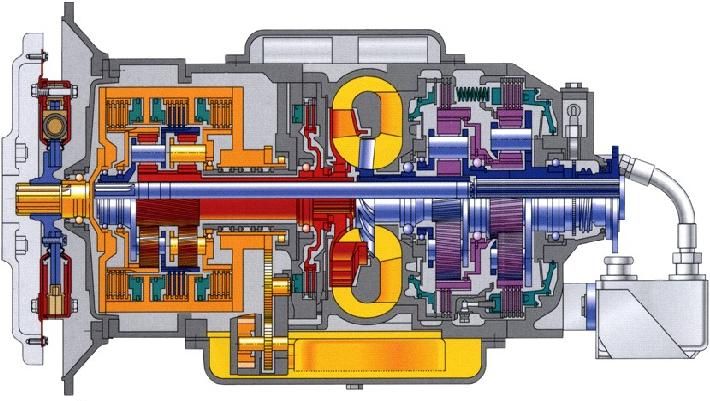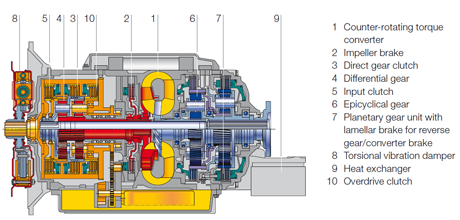 by "Cé hé sin" (michael-m-mouse)
by "Cé hé sin" (michael-m-mouse)
Published 01/27/2017 at 15:49
 by "Cé hé sin" (michael-m-mouse)
by "Cé hé sin" (michael-m-mouse)
Published 01/27/2017 at 15:49
Tags: Voith
; Diwa
STARS: 7
Time to dive into the complex world of the torque converter automatic transmission. These, as many of us know, give the impression of having been designed in an alternative reality and thus of presenting Alternative Facts.
Meet the Voith Diwa. This is quite simple, at least by the standards of automatic boxes.
By any normal measure, it’s hideously complicated.

We’ll need some annotation so here’s the biggest image in English that I could find.

As usual in images like this, power goes from left to right. It first encounters one of these, an epicyclic gear set, without which few automatic boxes would be complete, and drives the outer ring or annulus gear using the input clutch, no 5

The planet gears and their carrier turn in the same direction as but slower than the ring gear and the sun wheel turns in the opposite direction. In this case the planet carrier is attached to the blue shaft going right through the box which drives the wheels. The sun gear, which is the left hand part of the red assembly, spins the impeller part of the torque converter which is in the middle. The impeller stirs up fluid, this turns the turbine and the output from this also goes to the wheels., having been reversed on the way because the torque converter is spun backwards. Torque from the engine has two choices then. Drive the wheels mechanically via the planet carrier or hydraulically via the torque converter. Like the rest of us, torque is a lazy creature and takes the easiest way by driving the torque converter which slips at low speed and so is easy to turn. Apply some revs then and off we go in first gear. As we speed up, interesting things happen. The converter slips less, it gets harder to turn and so torque tends to drive the planet carrier and hence the wheels instead. We then have a gradual transition from hydraulic to mechanical drive as speed increases and a corresponding increase in gearing as slip decreases. Once we’ve reached the end of first gear we’ll need second. To create this, the impeller brake, no 2 on the diagram, is applied. This brings the torque converter to a juddering halt, or preferably a smooth one. At the same time another clutch on the turbine end of the converter is released so that the wheels don’t drive this against the resistance of the locked impeller. With the torque converter now out of the equation all torque is now going to the wheels via the planet carrier and as the sun wheel is now locked (because it’s attached to the impeller) the planet carrier must turn faster. That’s our second gear.
From here on everything happens entirely mechanically using the gears at the input side of the converter.
There are two epicyclics on the input side, both sharing a sun wheel (red). We began by driving the ring gear of epicyclic no 1. For third, we release the input clutch which had been driving the first ring gear and instead engage no 3 in the diagram, the direct clutch. This drives the ring gear of epicyclic no 2 at engine speed. The sun wheel (because it’s shared with epicyclic no 1 and attached to the locked torque converter) can’t turn so the planet carrier turns with, but slower than, the ring gear. For the time being it’s not connected to anything so just spins aimlessly. Now for the clever bit. The ring gear of epicyclic no 2 is attached directly to the planet carrier of epicyclic no 1 and as we already know this turns the wheels. Ring gear 2 is turning at engine speed so planet carrier 1 turns at engine speed and now we have a direct third gear. As originally designed that’s as far as you got but then a fourth was added.
Our last step so is to engage fourth. This involves swapping two clutches. The direct clutch which had been driving ring gear 2 is released and instead the overdrive clutch, no 10 in the diagram, is engaged. This drives the planet carrier of epicyclic 2 at engine speed. The sun is still locked so the ring gear has no choice but to turn faster than the planet carrier, that is faster than engine speed. The ring gear is still attached to planet carrier 1 so this is now being turned at faster than engine speed and as it’s still driving the wheels we now have an overdrive fourth.
That leaves the two epicyclics at the output side of the torque converter. One provides reverse and the other provides a unique feature of the Diwa, a built in retarder. You’ll remember that the torque converter’s turbine had been disconnected from the wheels in creating second gear because otherwise it would fight against the locked impeller. Well, sometimes we want that to happen. This gearbox is used on city buses, they stop and start very frequently and would be hard on brake linings unless we help them with a hydraulic retarder and rather than fit one we find that we already have the makings of one. Just engage the turbine clutch again. The impeller is still locked so now the wheels will drive the turbine, the turbine can’t drive the impeller so instead the energy is dissipated by stirring up and heating the fluid in the converter which is then passed through the heat exchanger (no 9 in the diagram).
So there we go. Four speeds, part mechanical drive in first, completely mechanical drive in all other gears and a built in retarder.Voith claim that the unusual first gear provides a kind of CVT so that it can take the place of at least two conventional gears with fewer gearchanges and therefore a smoother ride.
My limited experience is that the box is noisy and tends to hang onto first for ages.
 "RamblinRover Luxury-Yacht" (ramblininexile)
"RamblinRover Luxury-Yacht" (ramblininexile)
01/27/2017 at 15:56, STARS: 1
The playing off against one another of two resistances dependent on drive speed remind me a bit of the electromagnetic drive of the Owen Magnetic.
 "Urambo Tauro" (urambotauro)
"Urambo Tauro" (urambotauro)
01/27/2017 at 17:02, STARS: 1
*Derp* You said annotation , and somehow I read that as animation . I stared at the pic for a few seconds before I re-read the sentence haha.
 "bhtooefr" (bhtooefr)
"bhtooefr" (bhtooefr)
02/05/2017 at 22:33, STARS: 0
Have you covered anything like the Buick Flight Pitch/Triple Turbine Dynaflow or Chevrolet Turboglide? (Maybe in the form of a train or bus gearbox or something using the same ideas?)
 "Cé hé sin" (michael-m-mouse)
"Cé hé sin" (michael-m-mouse)
02/06/2017 at 06:18, STARS: 0
Not as of yet (there’ve been several of these torque split ones, Ford and ZF have used them too).